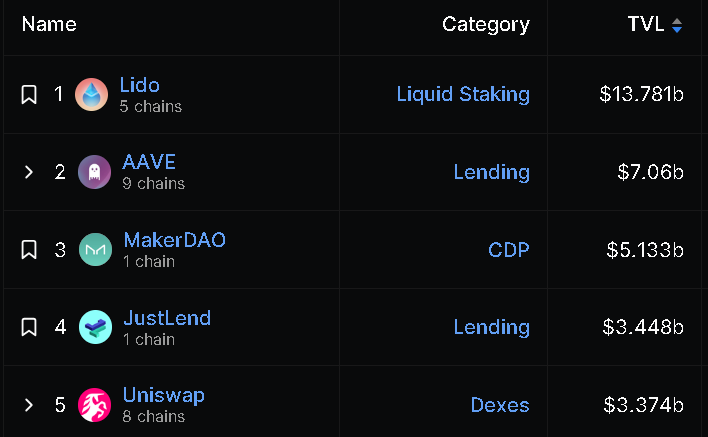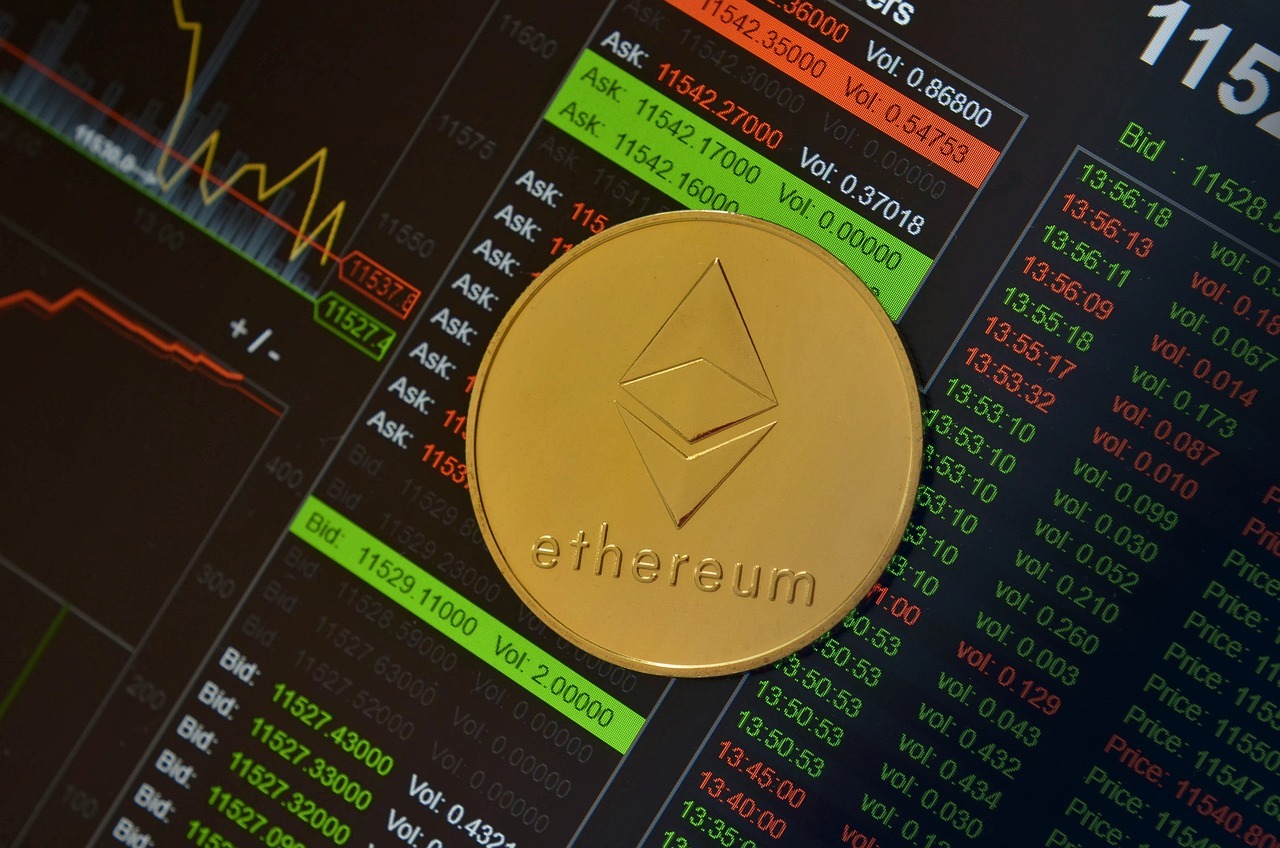Decentralised finance (DeFi) is among the most high-profile niches within the overall crypto industry, along with stablecoins and cryptos native to the top blockchains. When it comes to putting crypto funds to active use, DeFi platforms are often the first choice considered. In this article, we take a look at the 5 largest DeFi protocols by total value locked (TVL).
Top 5 of DeFi
When considering DeFi coins, market capitalisation data is rarely the best ranking criteria. DeFi platforms thrive on actively attracting and turning over crypto funds. Total value locked (TVL) on the platform is therefore the key success measure in this niche of the crypto world. A battle of giants in DeFi is always a battle of TVLs. Based on the current (23 August) TVL figures, here are the top 5 DeFi protocols:

Image source: DeFiLlama.com
1. LIDO (LDO) – TVL $13.8 billion
The leader of the DeFi world by TVL, Lido is a protocol that offers a solution for staking ETH on the Ethereum blockchain. Without using Lido, staking ETH directly on the chain requires at least 32 ETH ($52,900). Additionally, you would need to join the blockchain as a validator node and be connected to it 24/7 to help process transactions. The entire tech setup and the hefty minimum amount requirements make direct Ethereum staking inaccessible for the majority of crypto users. However, with Lido, users can stake ETH starting from minimal amounts and without the complicated technical setup.
Lido allows users to stake their ETH and receive the stETH tokens in return. The stETH represents the staked ETH plus rewards, but it is liquid and can be used in other DeFi protocols. Lido was launched in December 2020. While it primarily focuses on Ethereum staking, the protocol also offers similar solutions, albeit on a much more limited scale, on Solana, Moonbeam, Moonriver, and Terra Classic.
Lido’s native token, LDO, has so far posted a yearly loss of 24%. Compared to Bitcoin’s yearly growth of 21%, this is far from an impressive result. While Lido has maintained a confident lead in the DeFi industry by TVL, its LDO coin has been less successful.
2. AAVE (AAVE) – TVL $7.1 billion
AAVE is a decentralised lending platform that allows users to lend and borrow crypto assets in a trustless manner. What differentiates AAVE from traditional lending platforms is its use of "aTokens." When a user deposits an asset into the AAVE protocol, they receive a corresponding amount of aTokens, which automatically earn interest over time. Borrowers, on the other hand, can take out loans by providing collateral. The protocol uses a decentralised governance model where AAVE token holders can make decisions about the future direction of the platform. AAVE was originally launched as ETHLend in November 2017 and later rebranded and launched as AAVE in January 2020. AAVE operates primarily on the Ethereum blockchain but is also available on eight more layer 1 and layer 2 platforms – Polygon, Avalanche, Arbitrum, Optimism, Metis, Fantom, Base, and Harmony.
The AAVE token has lost 37% over the last one year, the worst performance among the top 5 DeFi coins.
3. MakerDAO (MKR) – TVL $5.1 billion
MakerDAO is the decentralised organisation behind the DAI stablecoin, which aims to keep its value pegged close to $1 USD. The system is maintained by a series of smart contracts on the Ethereum blockchain. MKR is the governance token of the MakerDAO system. Owners of MKR tokens have the right to vote on proposals that dictate the direction of the system. One of the core features of MakerDAO is its collateralised debt positions (CDPs), where users lock up crypto funds as collateral to generate DAI. If the value of the collateral drops too low, it gets liquidated to ensure that DAI remains stable. MakerDAO is the oldest among the top DeFi platforms. It has been around since 2015. and operates on the Ethereum blockchain.
The MKR token is the only one in our top 5 list that has generated positive returns over the year. It has grown by 21% in that period, matching Bitcoin’s ROI.
4. JustLend (JST) – TVL $3.4 billion
JustLend is a DeFI lending protocol operating on the TRON blockchain. It allows users to supply and borrow assets, similar to other lending platforms in the DeFi space. JustLend aims to create an algorithmic money market on TRON, offering features like supply, borrowing, and earning interest. By depositing assets, users earn interest over time, and by providing collateral, they can borrow other crypto assets. The JST token is associated with the protocol and serves multiple purposes, including governance, where JST holders can participate in voting for the development and changes in the platform. JustLend was launched around late 2020 and functions only on TRON.
JST, similar to the AAVE token, hasn’t had the best year, with a yearly loss of 33%.
5. Uniswap (UNI) – TVL $3.4 billion
Uniswap is one of the pioneering decentralised exchanges (DEX) built on the Ethereum blockchain. It was among the first exchange platforms to employ an automated market maker (AMM) model, allowing users to trade Ethereum-based tokens in a fast and efficient manner. Besides coin swapping, users can also provide liquidity to the platform by depositing equal values of two tokens into a liquidity pool. In return, they receive liquidity provider (LP) tokens that represent their share of the pool and earn a portion of the trading fees. UNI, the native token of Uniswap, was introduced in September 2020 and serves as a governance token. UNI token holders can vote on proposals that shape the future development and operation of the platform. Uniswap primarily operates on the Ethereum blockchain. Similar to AAVE, it is also represented on a wide variety of other layer 1 and layer 2 platforms, including Arbitrum, Polygon, Optimism, Celo, BNB Chain, Base, and Avalanche.
Over the last year, the UNI token has lost exactly as much as JustLend’s JST – 33%.
The five DeFi giants above all maintain massive TVL amounts by the standards of the industry. The youngest among them are already in the third year of their operation and have built up a solid footprint, judging by their TVL leadership. However, four out of five native tokens of these DeFi players have suffered significant price losses over the last year. This shows that while these platforms are actively used, their native tokens haven’t yet gained the trust of the crypto investor crowd. In other words, active DeFi crypto traders are flocking to these platforms, but long-term oriented crypto investors are still wary of these protocols’ stability and longevity.
A notable exception here is MakerDAO’s MKR token, a cryptocurrency that has posted a solid 21% yearly ROI. Perhaps Maker’s longevity on the market acts as its key distinctive feature, providing higher levels of assurance to long-term investors. MKR has long been on the list of the top HODL coins, and we are now seeing its gradual rise amidst the wider losses in the DeFi space.

